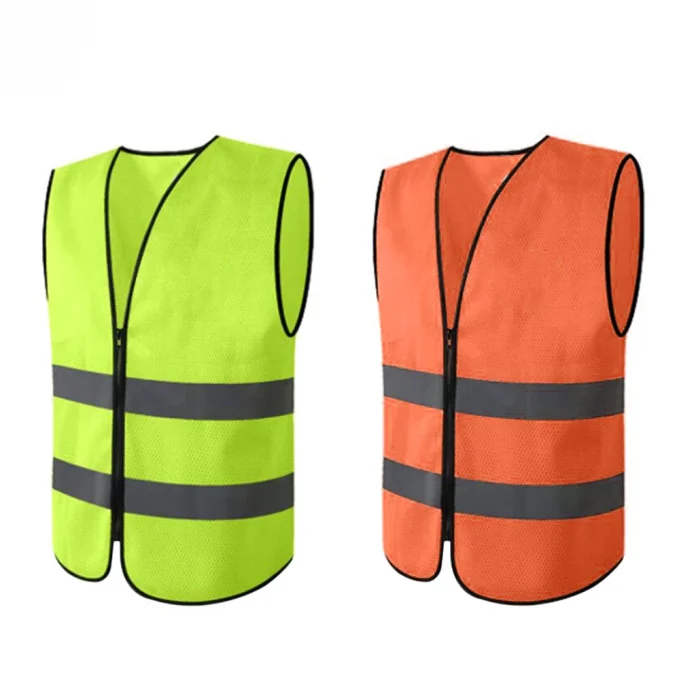If you’re in the market for a high-visibility safety vest, you may be wondering what to look for. To start, here’s what a safety vest is, how it works, and what the standards are for them. You’ll also learn about the classification system used for safety vests and how to determine which one is right for your specific needs. After all, you should be visible from all sides, so drivers can see you if they’re driving or operating a heavy machine.
What is a Safety vest?
High-visibility clothing is often known as hi-vis or viz and is worn on the arms and torso to increase visibility. It can be made of any material but is usually reflective. The purpose of high-visibility clothing is to prevent workers from becoming injured in an accident.
The wearer of such clothing should have a safety vest on at all times. Hi-vis clothing has a variety of uses and is important for a number of different industries.
High-visibility safety vests can help employees identify themselves in an emergency. Class 3 vests are used by workers who work in high-traffic areas, such as those in construction and maintenance jobs. The vests should make them easy to spot by drivers and pedestrians and should be as visible as possible.
These vests have reflective strips and are usually a minimum of 155 square inches. However, these vests may not meet all ANSI requirements, and workers should consider the risks of working in a low-light environment before purchasing one.
High-visibility safety vests are commonly used for construction and emergency services workers. They can also be worn by cyclists and motorcyclists near busy highways. Reflective vests can also increase a worker’s visibility to other motorists and cyclists. They can also be worn by runners or cyclists in high-traffic areas. This safety clothing can make them more visible and prevent them from being injured.
How Do Safety Vests Work?
The main function of high-visibility safety vests is to increase worker visibility. They do this by reflecting light back to the source of light. These vests have different levels of reflective material, with the highest levels being more visible at night.
Some vests are water-resistant and waterproof. Some vests meet specific ASTM and AATCC standards. The background material can be either white or silver to reflect light in a certain direction. The pockets can be shaped to hold specific items or have grommet holes.
These vests are available in a variety of colors. The brightest vests are used for workers in high-traffic areas and in situations where visibility is crucial. These safety vests allow workers to be seen and alerted to their presence and thus increase worker productivity.
However, this doesn’t mean that every high-visibility safety vest is suitable for all types of work. For example, workers in warehouses and construction sites often need Class O vests.
Using high-visibility safety vests can help your business grow by building a strong brand identity. By being visible, potential customers can trust you and your company. Using safety vests in the workplace can strengthen brand identity and prevent workplace accidents and injuries.
While you may not have known it, they can help your employees protect their health and save lives. If you have been thinking about investing in high-visibility vests, you should know that they can help your company’s bottom line.
Standard for Safety Vests
There are many different types of high-visibility safety vests. The Type R vest, for example, is designed for construction workers, airport ramp workers, and other municipal and DOT workers.
The Type R Class 3 garment is for flaggers and other public safety workers whose jobs require high-visibility clothing. Both types of safety vests are required by law, and neither type is too visible nor too heavy.
To be compliant, hi-vis clothing must be easily seen by people operating vehicles, machinery, and equipment. Hi-vis vests should have a 360-degree visibility range, so that drivers can see the wearer and stop.
The latest version of the ANSI/ISEA 107 standard is based on a balance between back and front visibility. Designed with safety in mind, hi-visibility garments should meet these requirements.
A high-visibility safety vest must be made with a minimum amount of two materials: a background material and a retroreflective material. Fluorescent material is highly visible during the day, while retroreflective materials reflect light in the opposite direction.
They both reflect light, so it is important to choose the correct type of material for your workplace. Some safety vests come with mic tabs and shoulder straps, but they should not be worn with a fall protection harness.
Classification of Safety Vests
There are three categories of high-visibility safety vests: class 1, class 2 and class 3. The difference between these categories is in their reflective properties. Class 2 vests are designed to be lightweight and durable while class 3 vests are made for high-risk work environments and require more reflective material and specialized cutouts. Here are some common applications for high-visibility safety vests:
For low-impact work, class one safety vests are used. These are used by workers in low-traffic areas that don’t encounter traffic speeds greater than 25 mph. Such workers may include parking attendants, roadside service personnel, and delivery drivers.
These vests are usually lightweight and sleeveless. Class one vests are typically used for jobs that don’t involve a high amount of exposure to traffic, such as walking in the streets or repairing sidewalks.
Depending on the industry, high-visibility safety vests can be worn in a variety of settings. These high-visibility safety vests are often required by the American National Standards Institute (ANSI) to meet safety standards.
ANSI is the body’s standards-based organization that oversees conformity standards for all industries in the U.S. ANSI was responsible for creating the American National Standard For High-Visibility Safety Apparel.
Importance High-Visibility Safety Vest
A high-visibility safety vest is an important piece of protective clothing for workers. Depending on the environment, the colors of customized Safety vests can play an important role. can come in different and can be customized as Safety Vests for specific uses. For instance, a vest may come with a pocket on the inside, an exterior pocket, or both.
The pockets can be designed to serve different purposes. Other features of a safety vest include closures, such as Velcro, zippers, or breakaway designs. A visibility vest may also feature a badge holder and company logo.
High-visibility safety vests also make it easier for others to spot workers in case of an emergency. If the construction site is unfamiliar to passersby, workers wearing high-visibility vests can help other workers find them and help them if an accident occurs.
In addition to saving lives, high-visibility vests also improve confidence while working. Workers wearing them can be more confident at work and can identify their team members easier.
High-visibility safety vests are an investment in worker safety, particularly for facilities that use large and powered machinery. They also make comfortable clothing for workers. Wearing a safety vest is more likely to be successful if it does not require complicated operations.
Additionally, high-visibility vests fit a wide range of body types. In addition, bright, reflective accents can be used to better distinguish crew members in hazardous locations.
Types of Safety Vests
There are many different types of high-visibility safety vests. The most important factor in choosing one is the type of job that requires it. Some are more visible than others, while others are a combination of both.
Public safety vests are different from regular ANSI vests, and their primary function is to maximize their wearer’s ability to access emergency tools. Previously, paramedics and police officers had to wear regular ANSI vests that often hung over their belts. Public safety vests were a better and more functional solution.
ANSI has set requirements for the different types of high-visibility safety vests. Class 3 vests are the largest, and are made of 1,240 inches of background fabric with 310 square inches of reflective striping. They are designed to resemble a short sleeve t-shirt.
However, they should be used for a variety of jobs. For example, a worker may work in a forest where there are high traffic areas. A worker who works near a road at night may need to wear a class 3 vest.
When selecting high-visibility safety vests, it’s important to consider the type of lighting you’ll be exposed to. In order to increase your visibility at night, choose one that is reflective. Vests that reflect light from headlights and streetlights can help you spot other workers.
To ensure visibility, make sure the material used is reflective and has minimal gaps. Some even have reflective striping to improve daytime visibility.
High-Visibility Safety Vests buying Factors
If you work in a hazardous environment, high-visibility safety vests are an absolute must-have. These vests are made from materials that provide increased cut resistance, such as polyester or kevlar, and some are even layered to provide more insulation.
Others have mesh panels to allow workers to breathe easily and keep cool. If you don’t know which material you need, ask a safety professional.
Reflective fabrics enhance visibility in dark conditions. They are essential for many high-risk environments, including construction sites. Heavy equipment operators can’t see you and cause an accident if you’re not wearing reflective clothing.
High-vis clothing is comfortable, durable, and meets minimum standards of retro-reflective material. These are just a few of the many factors to consider when purchasing a high-vis safety vest.
Class 3 safety vests are best for workers in high-risk environments, such as those involved in construction or landscaping. They should be two inches wide. The material on Type P and Type R is approximately 1,240 square inches.
Both types have short sleeves, which makes them suitable for working in inclement weather and in low-light conditions. The three performance classes for clothing are listed in the ANSI 2015 edition.


